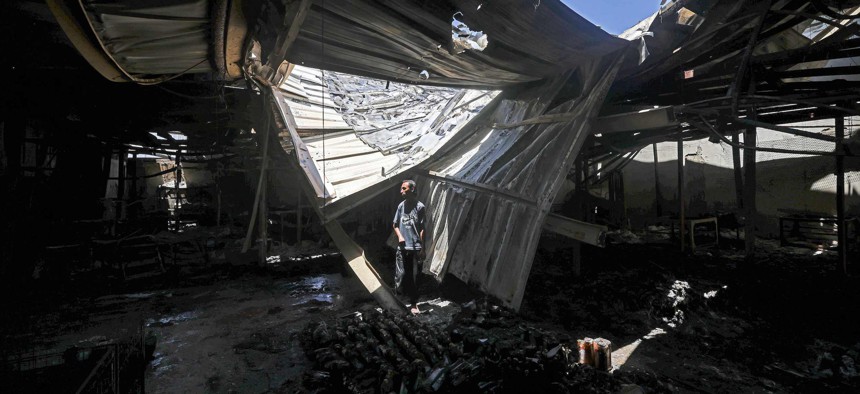
A Palestinian worker salvages items from a damaged factory in Gaza's industrial area, on May 25, 2021. Photo by MAHMUD HAMS/AFP via Getty Images
Three Political Crises Drove the Gaza Violence
Millions of civilians were endangered by three sets of beleaguered politicians who lack a popular mandate.
While the explosions, air raid sirens, and images of rubble led many to interpret the recent violence between Israelis and Palestinians as a military crisis, it was really the product of three simultaneous political crises. If Secretary of State Tony Blinken is to achieve any lasting results during his swing through the region, he must seek not just to cement a ceasefire but to revive cross-border discussion.
The first political crisis is in Gaza. Hamas has controlled the Gaza Strip since in 2007, but Hamas is no unified actor. The organization is split between its political and armed wings, and its Gaza organization and its organization outside Gaza. Because Hamas operates in secret, understanding the forces at play is difficult, and understanding how to influence them is more difficult still. Even so, Yahya Sinwar’s narrow reelection as the head of Hamas’ Gaza political bureau in March suggests underlying tensions, as does the sudden ubiquity of political chief Ismail Haniyeh after years of quiet.
It may be that Hamas’s Gaza apparatus sought to precipitate an external crisis in order to forestall an internal one. While Israeli commentators had noted Sinwar’s supposed pursuit of a long-term “calm” with Israel, this month’s actions seem to have made a calm less likely and weakened Hamas’s standing to negotiate. It seems less clear than ever who can speak for Hamas, or what Hamas wants.
The second political crisis is in the Palestinian authority. President Mahmoud Abbas was elected in 2005 and has stayed on 12 years past his mandate. His April cancellation of Palestinian legislative elections—which his allies seemed sure to lose, and where Hamas seemed poised to increase its standing—also scrubbed the presidential elections that were to follow in July.
Abbas rose as Yasser Arafat’s political deputy, but he has never been widely popular. His approval has dropped steadily through the years, and he was the first choice of only 9 percent of Palestinians polled recently. At 86 years of age, many Palestinians see him as the ruined candidate of unfulfilled promises and broken dreams.
Amid rising Palestinian disgust with corruption, it is perhaps little wonder that the most popular candidate for the Palestinian presidency was Marwan Barghouti, who has spent the last 19 years in Israeli prisons. It is unclear what Palestinians’ apparent eagerness to vote for an imprisoned candidate represents. Their identification with his suffering? The projection of their views on a relatively blank slate? The belief that a prisoner could be president just as effectively as Yasser Arafat was when he was besieged in his Ramallah headquarters? What it doesn’t represent is a leadership with legitimacy, or a political process that is poised to produce legitimate alternatives.
The final political crisis is in Israel. Prime Minister Binyamin Netanyahu’s fate has convulsed Israeli politics for two years. Former allies have turned to enemies, and a corruption trial swirls around him. An unprecedented four elections in two years were inconclusive, and he had just failed to assemble a government when violence broke out. Netanyahu continues as Israel’s caretaker prime minister while the Knesset seeks to find a compromise to avoid a fifth election.
The singular attention on Netanyahu has drawn Israelis’ attention away from a wide range of other political issues. Indeed, the sheer ideological incoherence of the anti-Netanyahu coalition suggests something awry in Israeli politics. One issue that Israelis seem further away from agreeing on than ever is Israel’s future relationship with the Palestinians. To some Israelis, strong support from the Trump administration, and the peace agreements Netanyahu struck with the United Arab Emirates, Bahrain, Morocco and the Sudan had obviated any need for urgency on the Palestinian file.
Much of the commentary on the last few weeks has focused on Hamas’s rockets, Israel’s Iron Dome defense system, and Israeli efforts to destroy Hamas infrastructure in Gaza. Some has talked about the surprising solidarity between Arab Israelis and Palestinians in recent weeks, and the rise of Arab-Jewish violence in Israel. But almost none of the commentary has focused on the real issue, which is that the violence was carried out by three sets of beleaguered politicians who lack a popular mandate.
The United States has limited tools to shape politics overseas—with close partners, inside designated terrorist organizations, or anywhere else. Further, the Biden administration has little appetite to wade into Palestinian-Israeli diplomacy, and for good reason. But its partnership with Israel, and its aspirations for Palestinian self-determination, create both the opening and the need for frank talk about what a future of endless violence looks like, and a serious exploration of alternatives for which most seem to have abandoned hope.
The two-state solution that was at the core of peacemaking for decades has been discredited on both sides of this conflict—not merely because it is undesirable, but because so many on both sides believe it is unachievable. To listen to them is to understand that for many, the disagreement isn’t with the “two state” part, but because they do not believe it represents a solution, and the adversary will continue to fight.
U.S. diplomacy needs to focus on exploring if there are satisfactory alternatives to two states, and if not, how some version of a two-state solution can be advanced that reassures critics on both sides. No one will be coerced, and the last month is evidence that no one is about to surrender, either. The political discussion that has lay dormant among Palestinians and Israelis needs to be invigorated. That is the most important thing that the United States can do, for its partners and adversaries alike.
NEXT STORY: Introducing ‘The China Intelligence’




